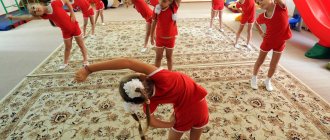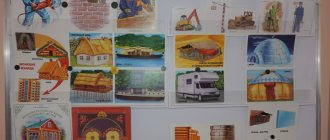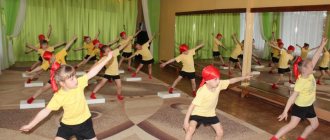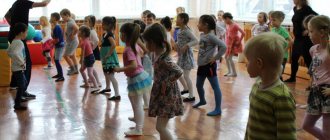Methodical instructions. Game situation "The Three Little Pigs".
Game situation "The Three Little Pigs".
Part I. The teacher sings a song to the piglets:
We are not afraid of the gray wolf, Gray wolf, gray wolf! Where do you go, stupid wolf, Old wolf, dire wolf?
Clarifies who sang this song and what fairy tale it is from.
The teacher attaches pictures of three piglets to the flannelgraph and, together with the children, remembers their names.
The teacher asks the children what needs to be done to find out how many piglets there are. Reminds children how to count piglets, how to make a generalizing gesture and say “only three piglets.”
The teacher calls the children one by one and asks them to count the piglets. Then he offers to treat the piglets with acorns. The children give each piglet one acorn. The teacher counts acorns together with the children. Based on the count, the guys are convinced that the piglets and acorns are equal.
Part II. The teacher shows the children the piglets' houses and suggests making doors of the required width to close the entrance to the houses.
The guys decide how wide the doors should be, compare them by width and select a door for each house.
Part III. There are paper tracks on the children's tables.
The teacher gives tasks: “What can you say about the length of the paths? Compare them by length. Which path will the piglet take to get to the house faster? (Short version.)
Show me the shortcut."
In the same way, children choose a tall Christmas tree from two Christmas trees to hide the pig’s house behind it.
Physical education minute
Children stand in a circle and first show a high Christmas tree (they rise on their toes and stretch their arms up), then a low Christmas tree (they squat down).
The exercise is repeated 2-3 times.
Part IV. Together with the children, the teacher looks at plot pictures depicting piglets at different times of the day. He clarifies what time of day is shown in the picture, asks the children to justify their conclusion and places the cards in order (morning, afternoon, evening, night).
Lesson 4
Program content
• Continue to learn to count within 3, correlating a number with an element of a set, independently designate the final number, and correctly answer the question “How much?”
• Improve the ability to distinguish and name geometric shapes (circle, square, triangle) regardless of their size.
• Develop the ability to determine spatial direction from oneself: above, below, in front, behind, left, right
.
Didactic visual material
Demonstration material.
Flannelograph, 3 bunnies, 3 carrots, circle, square, triangle, tray, bell.
Handout.
Two-page card, 3 squirrels, 3 nuts; circle, square, triangle (one shape for a child).
Lesson notes. Visiting the Three Little Pigs
Lesson notes for the course “Introduction to Mathematics” at the “Preschool” association of the Municipal Educational Institution of Preschool Educational Institution TsVR for children 5-6 years old.
Lesson topic
:
“Visiting the Three Little Pigs”
Lesson type:
Learning new material.
Lesson duration
: 30 minutes.
The purpose of the lesson
: introduce students to the formation and composition of the number three;
teach children to write the number three. Objectives: Educational:
- Teach how to correctly correlate the numbers obtained with the number of objects.
- To develop the ability to form numbers, teach students to write the number 3.
Educational:
- Develop mental processes: attention, thinking, memory, creative activity.
Educational:
- instill an interest in mathematics using the example of your favorite literary characters from famous fairy tales; the ability to listen and hear the teacher and other students.
Basic methods
, used during the lesson: game, verbal, visual, practical.
LESSON SUMMARY
- Organizing time.
(Slide demonstration No. 1) The call gave us a signal: The hour has come to work. So let’s not waste time and start working! 2. Emotional mood
Psychological mood for the lesson.
(Slide demonstration No. 2) In the morning the sun woke up Smiling from behind the clouds So all you and I have to do is Smile when we meet the ray!
Let's smile at the sun, the meadow and any blade of grass. Let's smile at each other. Just like that with you now! Let us smile and share our wonderful mood with each other. 3. Updating knowledge.
Guys, tell me, what number did we study in the last lesson?
- Which number comes first when counting? - What number follows it when counting? -Which number makes a pair? -Give an example pair.
Progress of the lesson: 1. Introducing the number 3. 1.1. Formation of the number 3. Teacher: - Guys, we remembered what we did in the last lesson. We got acquainted with the number and number two. And today we will get acquainted with a new number and a new figure. And to find out what this number is, I suggest you go to a fairy tale. Do you agree? Well, let's all close our eyes together and say the magic words: “One, two three, open the door to a fairy tale!” , now open your eyes - we are in a magical forest. (Slide demonstration No. 3. Music plays “Visiting a fairy tale”) The teacher reads a poem: In one magical forest,
Outwardly inconspicuous, There lived piglets, Oh! Funny boys. Outwardly they were very similar. They will not be distinguishable by a passerby. The same tail, snout, everyone has a pink side. Even the names are similar. Let's list them first: Nif is a braggart and a naughty girl. A very mischievous boy.
(The first pig appears on the screen with a click of the mouse)
Nuf is a fan of daydreaming, lying in a warm puddle. (
A second pig appears on the screen with a click of the mouse
) Naf – loves to work very much, will not forget anything.
(A third little pig appears on the screen when the mouse is clicked) - Guys, what kind of fairy tale do you think we are in?
(Children's answers - the tale of the three little pigs, the brothers Naf-Naf, Nif-Nif, and Nuf-Nuf lived in it). - That's right guys, this is a fairy tale of the three little pigs! Have you guys guessed what date we will meet you today? (Children's answers are the number three!) - That's right, guys, we will introduce you to the number three. -Look guys, we have piglets in the clearing. How many are there? (Children's answers: three). How did you find out how many piglets there are? (Children's answers - we counted them) 1+1+1 Well done. Right. There are really three of them. (Slide demonstration No. 4) As you guys know, our piglets are very restless and love to play and frolic. And they especially like to walk in their favorite meadow. One day Nif was playing ball in the clearing. (Slide demonstration No. 5) But he became bored playing alone. And then Naf and Nuf were walking nearby. -Nuf, Naf, let's go play ball. Nuf and Naf happily stayed to play in the clearing. (
Nuf and Naf appear on the screen with a mouse click) How many piglets played ball in the clearing?
Children's answers (Three!) How did you know? (Slide demonstration No. 6) How many piglets were there at first? And how many came later? How many are there in total? How did we calculate? 1+2 Well done guys. Our piglets played until lunchtime. And while they were playing and walking, they got tired and hungry. Our piglets went home for dinner. But as soon as they arrived home, Nif and Nuf were the first to run to the table. (Slide demonstration No. 7) And neat Naf first washed himself with soap and only then sat down at the table. (
Naf appears on the screen when you click the mouse
)
Tell me how many piglets had lunch?
How many were there at first? How much later? Three? How did we get the number 3? (Slide demonstration No. 8) 1+2 Well done guys! After lunch, our piglets went for a walk again. Only this time they went to the pond to see the familiar frogs. (Slide demonstration No. 9) Where every day after lunch a large frog choir performed. Let's all listen to the song that the frogs sang for our piglets and try to sing along with them. Do you agree? (Demonstration of slide number 10. On the screen there is a video sequence and a song sounds - the composition of the number three. We sing along with the children) - Tell me guys, how can we get the number three? (children's answers to 1+2; to 2+1; 1+1+1) Well done guys! We sang a song, and now I invite you to dance a cheerful dance. And the faithful friend of our three little pigs, a little pig named Piglet, will help us with this. Do you guys know this guy? What fairy tale is he from? Physical exercise. Dance “Cheerful Piglet.” (Slide No. 11. A physical exercise from Piglet sounds) - We quietly sit down in our seats. And we will find out what happened next. Evening came. And our piglets went to bed. (Slide demonstration No. 12. At the click of a mouse, the piglets go to their cribs.) And when they lay down in their cribs, they told each other for a long time fairy tales in which there are three heroes or the number three. And you and I will not disturb them, it’s time for us to return to our class. Let's close our eyes and say the magic words: “One, two, three, four - we have closed the doors to the fairy tale!” We are back in class. What fairy tale have we visited? Tell me guys, do you know any fairy tales where the number three appears? What are their names? (Three fat men, three bears, three sisters, three wishes, three sons, three heads for the Serpent Gorynych) Well done! You see how many fairy tales we know where the number three appears. The number “three” is a number from a fairy tale: Three wishes, three clues, Three bears, three horses And the king has three sons! (Slideshow 13-19) Guys, besides fairy tales, where else do you find the number three? (children's answers). He has only three eyes, but not all are open at once. If the red eye is open, it means he is angry - He does not give permission to move forward! Opens a yellow eye - Be careful now Wait for the green color near the eye. And I saw it - right away you can go and go! And bon voyage! Who is ready to answer us! How many eyes? How many flowers? (Slide number 20) That's right guys. How many colors are on the flag of our country? (Slide No. 21) How many wheels does a bicycle have? (slide number 22) How many angles does a triangle have? (slide number 23) Well, guys. Now let's get to work. In front of you is a sheet with a task. Color only those objects that are shown in threes in the picture. What objects did you color? Why didn't they color other objects? Well done boys! Now let's have a little rest, and I suggest you do some exercises with our cheerful Piglet. Physical exercise
“Little piglet was lying down on his side. So he stood up and stretched, Now he sat down, and now he bent over. He turned left and right, spun around, smiled! 2. Introducing the number three. Guys, who knows how we can designate the number three? (Slide 24) (Possible answers: lay out with chopsticks, point with fingers, indicate with the number 3) -The third digit in the number series is the number three! What is the third day of the week? What about the third month? -Look at number 3 (slide number 25) and listen to how the poet described it. No, just look at how beautiful the number three is! We only need to place two semicircles on top of each other. Look guys, this is what number three looks like. (the teacher distributes numbers to each child). Guys, where do you find the number three? (possible answers: on a ruler, on a blackboard, in a notebook, on the telephone keys, on the TV remote control, apartment No. 3). -Well, guys, let's see together where we can meet the number three. (Slide show No. 26-27-28-29-30) Well, then. We have become familiar with numbers, and it’s time for us to learn how to write them. See how you and I will do this. (Slide demonstration No. 31). The teacher duplicates on the board. (Practical task: Write down the number three). -Did you manage? Well done. -Tell me guys, what new did you learn in class today? What number did you meet? How can you and I get the number three? Now I invite you to evaluate today's lesson. If you didn’t like the lesson, then you can put the number three in your pocket - where a cloud, lightning and heavy rain are drawn. If you liked the lesson, but a lot is unclear, you can put your number in the pocket where the cloud frowns and the rain drips very lightly. And if you liked the lesson and everything is clear, you can put your number in your pocket where the sun shines. Thanks everyone for the lesson! And I wish everyone a good bright day and good mood!!!! (Slide show #32)
List of used literature: 1. Methodological recommendations for the course: “One is a step, two is a step...” Authors: L.G. Peterson, N.G. Kholina. 2. Three little pigs. Let's play a fairy tale. Didactic manual for kindergarten Authors: Veraksa N.E., Veraksa A.N. 3. https://www.youtube.com/watch?v=6KpkKV3RLtk 4. Pictures and animated pictures of the Yandex search engine
9









